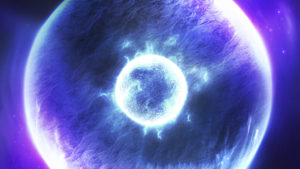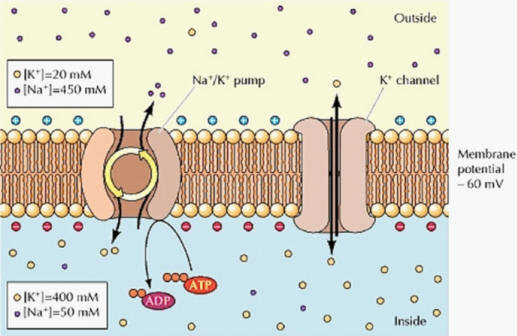


Electric Biology
Jun 30, 2010
Experiments with electrostatic fields might illuminate biological diversity.
A major problem in biology is the internal motion of proteins. Researchers from the University of Pennsylvania using Magnetic Resonance Imaging were surprised to discover that thecalmodulin protein molecule possesses an internal "jitter" that shakes it billions of times per second. This revelation led them to conclude that it is not merely the complex folded shape of such molecules that affects their function, but their internal movement.
According to Dr. Joshua Wand, “The situation is akin to the discussion in astrophysics in which theoreticians predict that there is dark matter, or energy, that no one has yet seen.”
Where the internal energy necessary for protein binding comes from is unknown at the present time, but it seems likely, based on research with electrostatic fields on various organisms, that there is an electrical component to the source. Cell walls are arranged in a double layer configuration with positive and negative ion channels built-in.
A book called The Primeval Code (Der Urzeit-Code) was recently published in Switzerland, detailing experiments that demonstrate how a changing electric field can alter gametes so much that new species are created.
According to author Luc Bürgin, "In laboratory experiments the researchers there Dr. Guido Ebner and Heinz Schürch exposed cereal seeds and fish eggs to an 'electrostatic field' – in other words, to a high voltage field, in which no current flows. Unexpectedly primeval organisms grew out of these seeds and eggs: a fern that no botanist was able to identify; primeval corn with up to twelve ears per stalk; wheat that was ready to be harvested in just four to six weeks. And giant trout, extinct in Europe for 130 years, with so-called salmon hooks. It was as if these organisms accessed their own genetic memories on command in the electric field, a phenomenon, which the English biochemist, Rupert Sheldrake, for instance believes is possible."
Electric Universe advocates recognize that plasma is a self-organizing phenomenon. Indeed, Irving Langmuir coined the name because he saw that collections of charged particles isolate themselves from their surroundings in ways that are similar to biological systems. A cell membrane could be thought of as a Langmuir plasma sheath, sustaining a voltage difference between the negatively charged interior and the positively charged exterior. Electric currents most likely maintain charge separation across the membrane layers.
Perhaps these observations can all be tied together. Sheldrake's "morphic fields," protein jitter, gamete alteration that leads to speciation, and the electric charges in cells might all be manifestations of plasma's emergent properties. At some time in the past, as these pages have repeatedly emphasized, Earth's electrical properties were substantially altered when other highly charged objects or ionic clouds passed close to our plasmasphere.
Intense electric arcs swept across the surface of the Earth, creating powerful electromagnetic fields that could have transmuted biological organisms in the same way that they changed the atomic structure of elements and minerals. The famous Miller-Urey experiment demonstrated that inorganic compounds exposed to electric currents can be altered to form organic chemicals like amino acids.
Given the report in The Primeval Code, it would not be too great a stretch to think that electric currents might cause proteins to shake at varying rates, thus changing their behavior, or triggering morphic fields to change state, creating new forms of life. Symbiosis, a longtime thorn in the side of evolutionary biology, might find its genesis in electricity.
Stephen Smith
Electric Biology
Jun 30, 2010
Experiments with electrostatic fields might illuminate biological diversity.
A major problem in biology is the internal motion of proteins. Researchers from the University of Pennsylvania using Magnetic Resonance Imaging were surprised to discover that thecalmodulin protein molecule possesses an internal "jitter" that shakes it billions of times per second. This revelation led them to conclude that it is not merely the complex folded shape of such molecules that affects their function, but their internal movement.
According to Dr. Joshua Wand, “The situation is akin to the discussion in astrophysics in which theoreticians predict that there is dark matter, or energy, that no one has yet seen.”
Where the internal energy necessary for protein binding comes from is unknown at the present time, but it seems likely, based on research with electrostatic fields on various organisms, that there is an electrical component to the source. Cell walls are arranged in a double layer configuration with positive and negative ion channels built-in.
A book called The Primeval Code (Der Urzeit-Code) was recently published in Switzerland, detailing experiments that demonstrate how a changing electric field can alter gametes so much that new species are created.
According to author Luc Bürgin, "In laboratory experiments the researchers there Dr. Guido Ebner and Heinz Schürch exposed cereal seeds and fish eggs to an 'electrostatic field' – in other words, to a high voltage field, in which no current flows. Unexpectedly primeval organisms grew out of these seeds and eggs: a fern that no botanist was able to identify; primeval corn with up to twelve ears per stalk; wheat that was ready to be harvested in just four to six weeks. And giant trout, extinct in Europe for 130 years, with so-called salmon hooks. It was as if these organisms accessed their own genetic memories on command in the electric field, a phenomenon, which the English biochemist, Rupert Sheldrake, for instance believes is possible."
Electric Universe advocates recognize that plasma is a self-organizing phenomenon. Indeed, Irving Langmuir coined the name because he saw that collections of charged particles isolate themselves from their surroundings in ways that are similar to biological systems. A cell membrane could be thought of as a Langmuir plasma sheath, sustaining a voltage difference between the negatively charged interior and the positively charged exterior. Electric currents most likely maintain charge separation across the membrane layers.
Perhaps these observations can all be tied together. Sheldrake's "morphic fields," protein jitter, gamete alteration that leads to speciation, and the electric charges in cells might all be manifestations of plasma's emergent properties. At some time in the past, as these pages have repeatedly emphasized, Earth's electrical properties were substantially altered when other highly charged objects or ionic clouds passed close to our plasmasphere.
Intense electric arcs swept across the surface of the Earth, creating powerful electromagnetic fields that could have transmuted biological organisms in the same way that they changed the atomic structure of elements and minerals. The famous Miller-Urey experiment demonstrated that inorganic compounds exposed to electric currents can be altered to form organic chemicals like amino acids.
Given the report in The Primeval Code, it would not be too great a stretch to think that electric currents might cause proteins to shake at varying rates, thus changing their behavior, or triggering morphic fields to change state, creating new forms of life. Symbiosis, a longtime thorn in the side of evolutionary biology, might find its genesis in electricity.
Stephen Smith